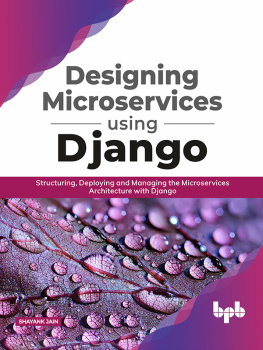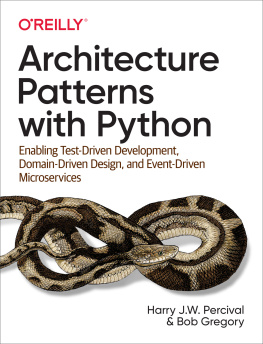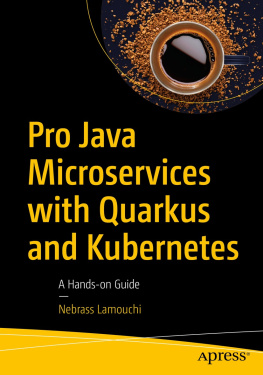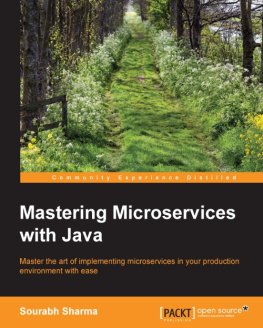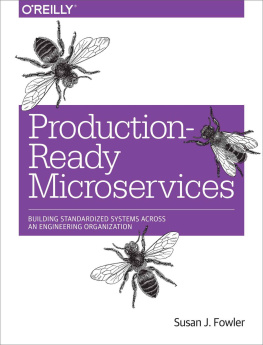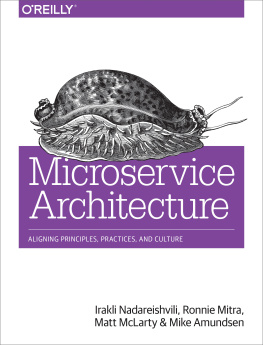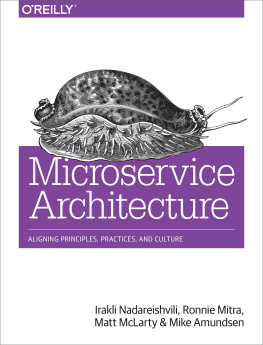Tomasz Jaskula - Strategic Monoliths and Microservices: Driving Innovation Using Purposeful Architecture
Here you can read online Tomasz Jaskula - Strategic Monoliths and Microservices: Driving Innovation Using Purposeful Architecture full text of the book (entire story) in english for free. Download pdf and epub, get meaning, cover and reviews about this ebook. year: 2021, publisher: Addison-Wesley Professional, genre: Business. Description of the work, (preface) as well as reviews are available. Best literature library LitArk.com created for fans of good reading and offers a wide selection of genres:
Romance novel
Science fiction
Adventure
Detective
Science
History
Home and family
Prose
Art
Politics
Computer
Non-fiction
Religion
Business
Children
Humor
Choose a favorite category and find really read worthwhile books. Enjoy immersion in the world of imagination, feel the emotions of the characters or learn something new for yourself, make an fascinating discovery.

- Book:Strategic Monoliths and Microservices: Driving Innovation Using Purposeful Architecture
- Author:
- Publisher:Addison-Wesley Professional
- Genre:
- Year:2021
- Rating:5 / 5
- Favourites:Add to favourites
- Your mark:
- 100
- 1
- 2
- 3
- 4
- 5
Strategic Monoliths and Microservices: Driving Innovation Using Purposeful Architecture: summary, description and annotation
We offer to read an annotation, description, summary or preface (depends on what the author of the book "Strategic Monoliths and Microservices: Driving Innovation Using Purposeful Architecture" wrote himself). If you haven't found the necessary information about the book — write in the comments, we will try to find it.
Tomasz Jaskula: author's other books
Who wrote Strategic Monoliths and Microservices: Driving Innovation Using Purposeful Architecture? Find out the surname, the name of the author of the book and a list of all author's works by series.
Strategic Monoliths and Microservices: Driving Innovation Using Purposeful Architecture — read online for free the complete book (whole text) full work
Below is the text of the book, divided by pages. System saving the place of the last page read, allows you to conveniently read the book "Strategic Monoliths and Microservices: Driving Innovation Using Purposeful Architecture" online for free, without having to search again every time where you left off. Put a bookmark, and you can go to the page where you finished reading at any time.
Font size:
Interval:
Bookmark:
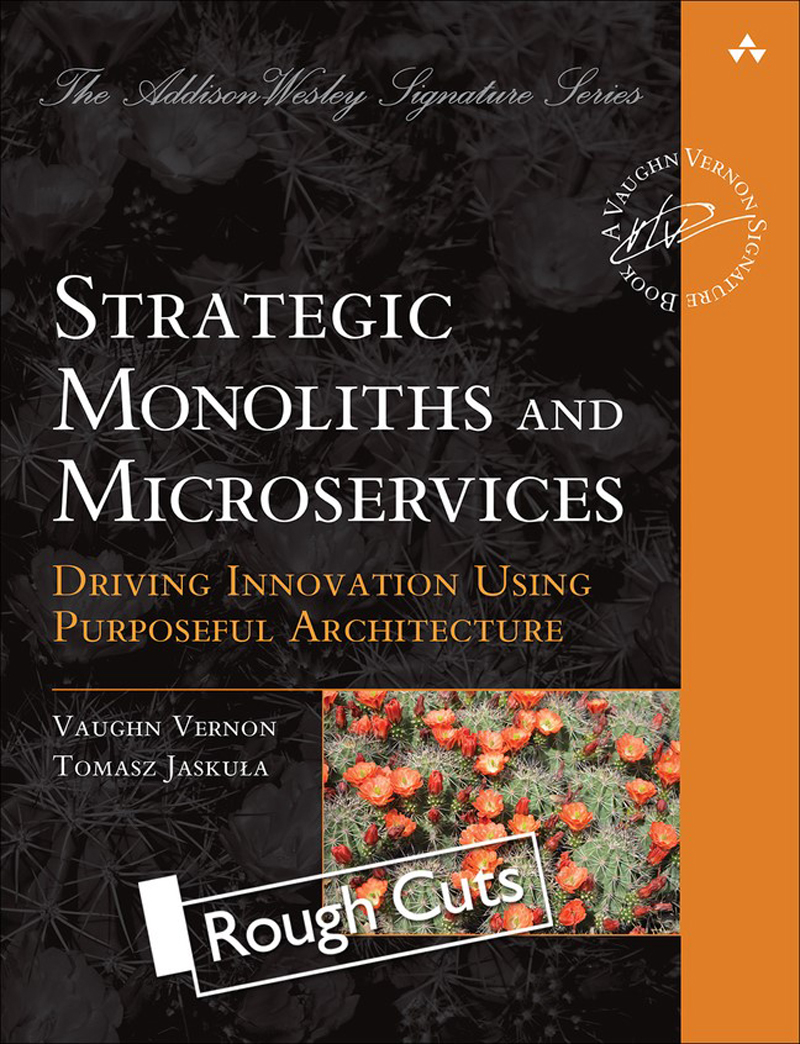
Driving Innovation Using Purposeful Architecture
Vaughn Vernon
Tomasz Jaskua

We met the founders of Iterate in April 2007. Three of them had attended our first workshop in Oslo and invited us out to dinner. There, we learned they had just quit their jobs at a consulting firm and founded their own, so they could work in a place they loved using techniques they believed in. I thought to myself, Good luck with that. After all, they were just a couple years out of college and had no experience running a business. But I kept my skepticism to myself as we talked about how to find good customers and negotiate agile contracts.
We visited Iterate many times over the next decade and watched it grow into a successful consulting firm that was routinely listed as one of Norways best places to work. They had a few dozen consultants and evolved from writing software to coaching companies in Test-Driven Development to helping companies innovate with design sprints. So I should have seen it coming, but when they decided to transform the company in 2016, I was surprised.
We decided to change course, they told us. We want to be a great place to work, where people can reach their full potential, but our best people are limited as consultants. They are always pursuing someone elses dream. We want to create a company where people can follow their own passion and create new companies. We want to nurture startups and fund this with our consulting revenue.
Once again I thought to myself, Good luck with that. This time I did not keep my skepticism to myself. We talked about the base failure rate of new ventures and the mantra from my 3M days: Try lots of stuff and keep what works. Thats a great motto if you have a lot of time and money, but they had neither. One of the founders was not comfortable with the new approach and left the company. The others did what they had always donemove forward step-by-step and iterate toward their goal.
It was not easy and there were no models to follow. Warry of outside funding, they decided to merge the diametrically opposed business models of consulting and venture funding by limiting the amount of profit they could make from consulting to 3%, pouring the rest back into funding ventures. They had to make sure that consultants did not feel like second-class citizens and those working on new ventures were committed to the success of the consulting business. And they had to learn how to successfully start up new businesses when all theyd ever started was a consulting business.
Its been five years. Every year we visited to brainstorm ideas as the company struggled to make their unique approach work. When the pandemic hit, not only did their consulting business grind to a halt, but the farm-to-restaurant business they had nurtured for three years had no restaurants left to buy local farm goods. But think about it: Iterate had top talent with nothing to do and a venture that was poised to collect and deliver perishable goods. It took two weeks to pivotthey offered the food to consumers for curbside pickupand the venture took off. While most Oslo consulting firms suffered in 2020, Iterate saw one venture (last-mile delivery) exit through a successful acquisition and three others spin off as separate entities, including a ship-locating system and a three-sided platform for knitters, yarn suppliers, and consumers. As a bonus, Iterate was number 50 on Fast Companys 2020 list of Best Workplaces for Innovators, ahead of Slack and Square and Shopify.
So how did Iterate succeed against all odds? They started by realizing that a consulting approach to software development did not give them the freedom to take a lead role. With software becoming a strategic innovation lever, they felt it was time to claim a seat at the decision-making table. This was scary, because it involved taking responsibility for resultssomething consultants generally avoid. But they were confident that their experimental approach to solving challenging problems would work for business problems as well as technical problems, so they forged ahead.
You might wonder what Iterates transformation has to do with the enterprise transformations that are the subject of this book. There is nothing in Iterates story about Monoliths or Microservices or agile practicesbut these are not the essence of a transformation. As this book points out, a transformation begins with the articulation of a new and innovative business strategy, one that provides real, differentiated value to a market. The pursuit of that strategy will be a long and challenging journey, requiring excellent people, deep thinking, and plenty of learning along the way. For those who are starting out on such a transformation, this book provides a lot of thinking tools for your journey.
For example, as you head in a new direction, you probably do not want to blow up the structures that brought your current success, however outmoded they might be. You need that old Big Ball of Mud Monolith (or consulting services) to fund your transition.
Another example: The first thing you want to consider is the right architecture for your new business model, and it probably wont be the same as the old one. Just as Iterate moved from having a pool of consultants to having clearly distinct venture teams, you will probably want to structure your new architecture to fit the domain it operates in. This usually means clarifying the business capabilities that fit the new strategy and structuring complete teams around these capabilities. So instead of having a layered architecture, you are likely to want one based on the natural components and subcomponents of your product (also known as Bounded Contexts).
Think of SpaceX: The architecture of a launch vehicle is determined by its componentsfirst stage (which contains nine Merlin engines, a long fuselage, and some landing legs), interstage, second stage, and payload. Teams are not formed around engineering disciplines (e.g., materials engineering, structural engineering, software engineering), but rather around components and subcomponents. This gives each team a clear responsibility and set of constraints: Teams are expected to understand and accomplish the job their component must do to ensure the next launch is successful.
As you clarify the product architecture in your new strategy, you will probably want to create an organization that matches this architecture because, as the authors point out, you cant violate Conways Law any more than you can violate the law of gravity. The heart of this book is a large set of thinking tools that will help you design a new architecture (quite possibly a modular Monolith to begin with) and the organization needed to support that architecture. The book then offers ways to gradually move from your existing architecture toward the new one, as well as presents ideas about when and how you might want to spin off appropriate services.
Over time, Iterate learned that successful ventures have three things in common:
Good market timing
Team cohesion
Technical excellence
Market timing requires patience; organizations that think transformations are about new processes or data structures tend to be impatient and generally get this wrong. Transformations are about creating an environment in which innovation can flourish to create new, differentiated offerings and bring them to market at the right time.
Font size:
Interval:
Bookmark:
Similar books «Strategic Monoliths and Microservices: Driving Innovation Using Purposeful Architecture»
Look at similar books to Strategic Monoliths and Microservices: Driving Innovation Using Purposeful Architecture. We have selected literature similar in name and meaning in the hope of providing readers with more options to find new, interesting, not yet read works.
Discussion, reviews of the book Strategic Monoliths and Microservices: Driving Innovation Using Purposeful Architecture and just readers' own opinions. Leave your comments, write what you think about the work, its meaning or the main characters. Specify what exactly you liked and what you didn't like, and why you think so.

